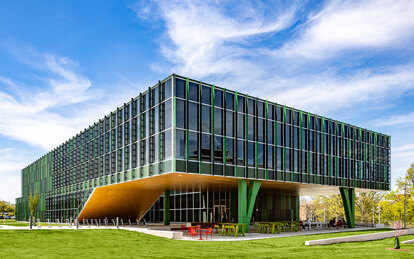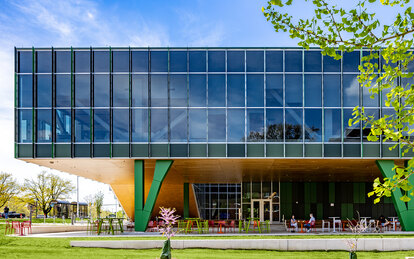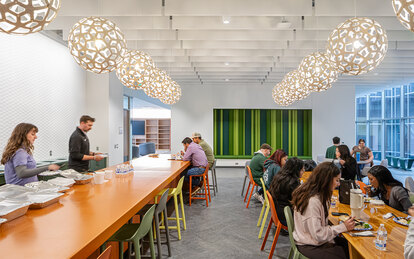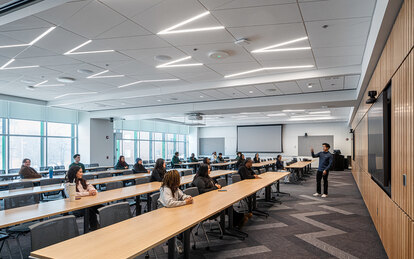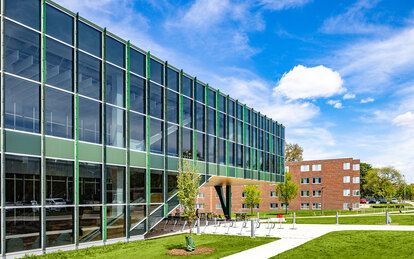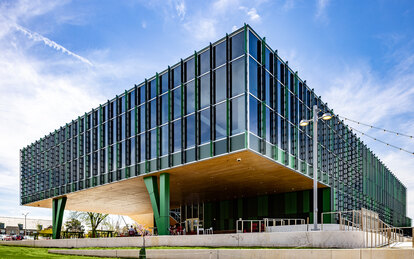Michigan State University - Multicultural Center
With a design guided by student voices, a new purpose-built center provides a safe community space that welcomes, educates, heals, honors and celebrates the diversity of the MSU student body.
客户
Michigan State University
位置
East Lansing, Michigan
市场/服务
Architecture, Cultural, Higher Education, Interiors, Justice, Equity, Diversity & Inclusion, Landscape Architecture, Lighting Design, MEP Engineering, Structural Engineering, Student Life, University Arts & Culture
大小
34,000 GSF
For students to succeed beyond the walls of an institution, it is essential to build a culture that values diversity, equity, and inclusion. Spurred on by students seeking a more just and equitable campus community and in response to decades of activism, MSU opted to replace an existing, undersized, multicultural student space with a prominent new building in the heart of campus.
As one of the largest, free-standing campus facilities of its kind in the nation, the MSU Multicultural Center aspires to both support and celebrate marginalized students. The Center’s design embodies diversity, equity and inclusion by subtly representing various cultures in a unified context. It empowers people to learn about who we are today and allows others to overcome their fear of what they may not understand nor have experienced. The Center aims to educate all on the richness of multiculturalism. It promotes education and engagement while celebrating collective histories. The design is inspired by the spirit of Sankofa and conceptualizes words like remembrance, erasure, intersection(ality), convergence, and education- supporting global social impact and sustainability, creating a safe and inclusive space for all.

Students were engaged throughout the entire design process- from the interview of design professionals, visioning, programming, and continuing through construction. The result is a building that is “by the students-for the students”. At its heart is the “living room,” providing a large communal gathering space that students had long sought, allowing them to host events and performances of cultural expression on site, rather than renting another facility. The living room features a lightwell that brings natural light into the center of the building and doubles as a beacon to the surrounding campus. A collaboration stair doubles as event seating, adding to the ground floor’s adaptability.
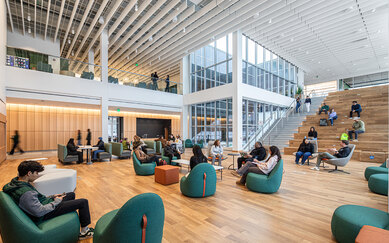
The entry corridor is clad in wood and provides gallery space to showcase the work of multicultural artists and artisans. The building’s overall interior palette is warm and neutral, creating a canvas for students that can reflect different cultural motifs over time.
A “community kitchen” serves as the social hub of the second floor allowing for students to commune around foods that are representative of their diverse heritage and cultures. This communal area is flanked by meeting areas for student organizations and more private spaces for those seeking seclusion for respite. The Center is designed to serve all and includes reflection rooms for meditation or prayer, ablution stations, and toilet rooms that service both non-binary and binary students.
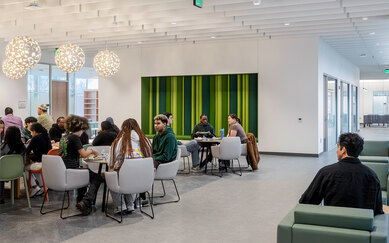
"There were more stakeholders and more diversity in stakeholder groups than any other project in the history of IPF. Student groups wanted spaces to support their needs, ranging from crafting and creating physical materials to dance to professional planning and resources that support students."
-Tiana Carter, Project Manager, Infrastructure Planning and Facilities, Michigan State University
The building exterior reflects the careful balance between prominence and protection. It blurs the lines between interior and exterior, at certain moments, by creating protected, programmable outdoor space adjacent to the entry and multipurpose rooms. A large, cantilevered entrance overhang provides an inviting yet sheltered outdoor events “porch”. The tiered amphitheater allows for performances where students can gather for cultural dance, music and events. A ceremonial area is designed into the site, near the Red Cedar River allowing First Nations to hold fire ceremonies for the first time on campus.
The facade is clad in perforated metal fins that add rhythm, texture, solar shading and privacy, expressed in multiple shades of Spartan green to subtly represent multiculturalism in a unified context.
The human condition is universal, regardless of culture, skin tone, body type, or country of origin. We are all variations of the human condition but share the same essence. This building will be more than its bricks and mortar, and its impact will extend far beyond its site.
